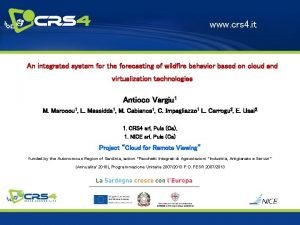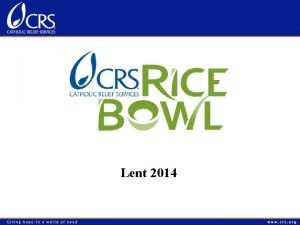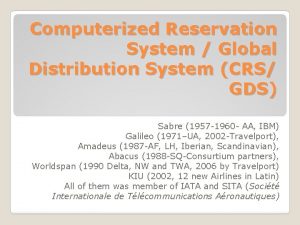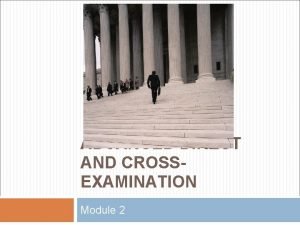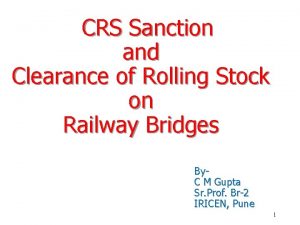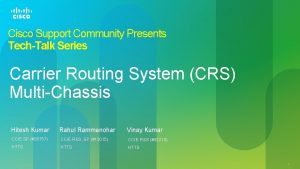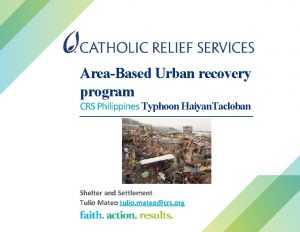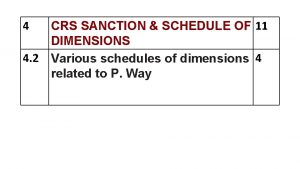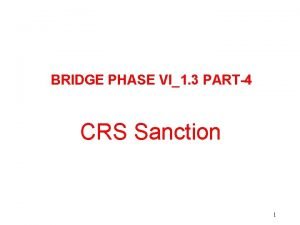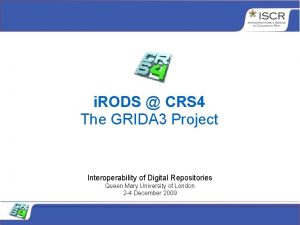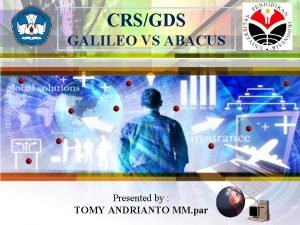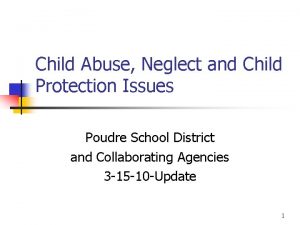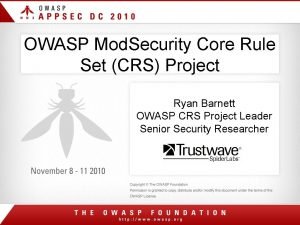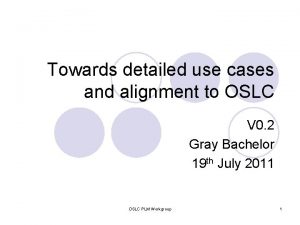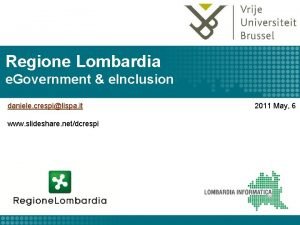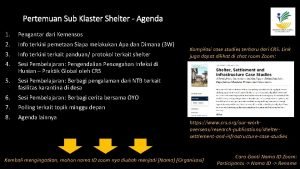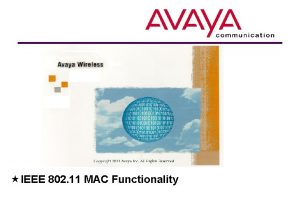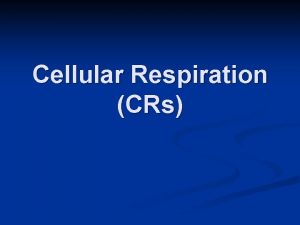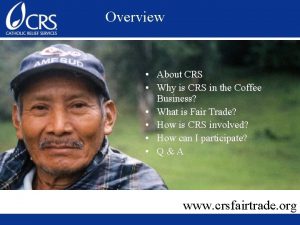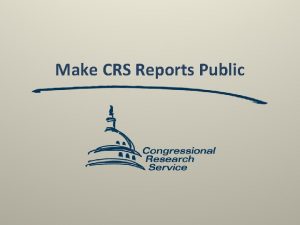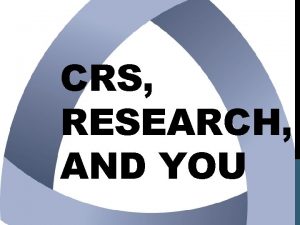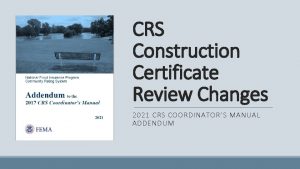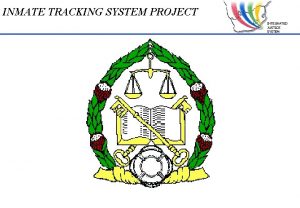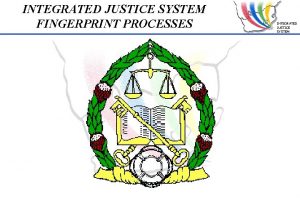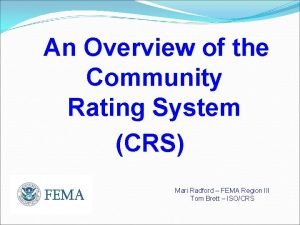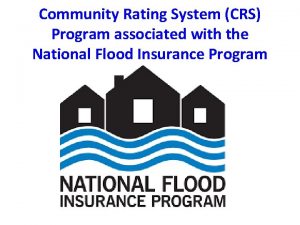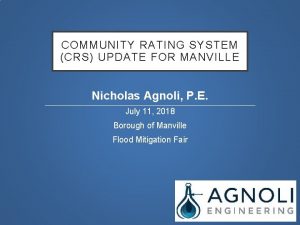www crs 4 it An integrated system for


















- Slides: 18

www. crs 4. it An integrated system for the forecasting of wildfire behavior based on cloud and virtualization technologies Antioco Vargiu 1 M. Maroccu 1, L. Massidda 1, M. Cabianca 1, C. Impagliazzo 1 L. Carrogu 2, E. Usai 2 1. CRS 4 srl, Pula (Ca), 1. NICE srl, Pula (Ca) Project “Cloud for Remote Viewing” funded by the Autonomous Region of Sardinia, action “Pacchetti Integrati di Agevolazioni "Industria, Artigianato e Servizi" (Annualita' 2010), Programmazione Unitaria 2007/2013 P. O. FESR 2007/2013

Topics CRS 4 Keywords: Rothermel's fire modeling, mass-consistent wind downscaling, cloud computing Scheme of the Presentation: • Introduction to the Wild. Fire Cloud Service • Data and Methods of the Wild. Fire Cloud Service • Test on relevant wildfire cases in Sardinia • Conclusions and future developments 2

Fire Behavior Modeling Principal issue: fire development and spread is driven by physical processes taking place at different scales. In order to run wildfire simulations is required the modeling (at the landscape scale) of: • Surface Weather Conditions (PBL). • Topography. • Land Cover and Fuel Representation. CRS 4 1 m 10 m Forest fire 100 m 1 km Land modeling PBL modelig 10 km 100 km Meteorology 1000 km To obtain realtime wildfire simulations, Rothermel’s semiempirical model is the most common approach. 3

The Wild. Fire Cloud Service CRS 4 Layout of the Cloud Wild. Fire Forecasting System • Modular design coded in Python with precompiled libs. • Easily changeable functional elements. • Custom-tailored setup. • Simple user interface based on the Cloud Computing paradigms: Suitable for: • Scenario analysis • Personnel training • Emergency management “Software as a Service” “Remote Desktop Virtualization” with support of 3 D GPU accelation 4

The Cloud Computing: the conceptual schema CRS 4 WEB INTERFACE REMOTE USERS Cloud Layers VIRTUAL RESOURCES PHYSICAL HARDWARE 5

A Weather Forecast system for Wildfire modeling BOLAM_Father: nlon=290, nlat=170, nlev=42 Dlon=0. 3° (30 km) CRS 4 BOLAM_Son: nlon=560, nlat=362, nlev=46 Dlon=0. 1° (10 km) Bolam-Moloch Weather Forecast Chain Run “on demand”: users can select position and time. Scheduled daily runs. No user interaction MOLOCH: nlon=722, nlat=674, nlev=51 Dlon=0. 03° (3 km) Lam-Mass-Consistent: nlon=861, nlat=1341, nlev=41 Dlon=0. 0021° (200 m) Wind. Potential. Foam; nx=300, ny=300, nz=35 dx=35 m Mass-Consistent Wind Model

Very High Resolution Wind Modeling CRS 4 Wind is one of the environmental variables which greatly influence the spread and intensity of wildland fires (Rothermel, 1972). Wind. Potential. Foam, a Mass-Consistent Wind Model based on the CFD software package Open. FOAM Issue: interpolated winds field show a flat unrealistic behavior near the terrain. Effective solution: MCM enforces a "divergence free” flow, computing an optimal mass-correction. A more realistic flow is obtained near the surface. Variational Formulation Lagrange Multiplier Approach Physically adjusted wind λ→ Scalar Potential Field ν ν 0 Equations soved on a Terrain-Following Mesh 7

Very High Resolution Wind Modeling CRS 4 Wind. Potential. Foam, a Mass-Consistent Wind Model based on the CFD software package Open. FOAM PROS CONS Fast Wind Model, suitable for realtime applications Diagnostic Model: Steady State, No dynamics, No turbulence Vertical corrections linked to the atmosphere stability Slight deviations from the initial wind V 0 Build in an advanced open source CFD platform. open. Foam: some libraries and/or tools too much resource-hungry, “ad hoc” modifications are required to speed-up realtime applications. 8

Wildfire modeling: Land Dataset CRS 4 Landscape Dataset (from www. sardegnageoportale. it) DTM Land Cover Raster resolution=10 m Corine Land Cover 2006 Raster resolution=20 m Alternative Global Dataset: SRTM Digital Elevation Database v 4. 1 ESA Glob. Cover 2009 resolution: 3 -arc seconds (~ 90 m at the equator) 10 -arc seconds (~ 300 m) 9

Wildfire modeling: Fuel Models CRS 4 Rothermel's fuel • 13 NFFL standard fuel models • A custom model for the Mediterranean Maquis (Arca 2007) Assessment of the Fuel Moisture Content • Fine Fuel Moisture (1 h) evaluated with the Viney model (Viney 1991). • Moisture Scenario for Thicker Fuel, (according to Scott 2005), scenario chosen by means of the 1 h value. • Seasonal adjustment factor for live and dead fuel. Arca B, Duce P, Laconi M, Pellizzaro G, Salis M, Spano D, 2007. Evaluation of FARSITE simulator in Mediterranean maquis. International Journal of Wildland Fire 16, 563– 572 Scott, Joe H. and Burgan, Robert E. (2005) Standard fire behavior fuel models: a comprehensive set for use with Rothermel’s surface fire spread model. General Technical Report RMRS-GTR-153. USDA Forest Service, Rocky Mountain Research Station, Fort Collins, Viney (1991), A Review of Fine Fuel Moisture Modelling, International Journal of Wildland Fire 1(4) 215 - 234 10

Wildfire modeling: The spread model and Fire Front Tracking CRS 4 The Surface Spread Model: ROS(x, t) We have developed specific Python Interfaces for the Rothermel libraries: • Fire. Lib, (1996, Collin D. Bevins). • Fire Behavior SDK (2006, Collin D. Bevins). (http: //www. fire. org) The Fire Perimeter evolution: To propagate the fire front the Fast Marching Method has been implemented. This method can automatically deal with topological changes of the burned area. It is a special case of the well known Level Set Method. (B U NB) > 1 • LSM solves the time evolution of the “zero isoline” over the NB subset. • FMM solves an equivalent “boundary value” problem over the unburned area ≤ 0 11

Wildfire modeling: Fire Front Tracking CRS 4 Fast Marching Method Optimal “One-Shot” method to compute the front evolution. The “Arrival Time” of the fire is estimated solving an linearized Eikonal equation over the unburned area (NB): (B U NB) T > 3 with V(x) ≥ 0: Rate Of Spread T(x): Arrival Time (or Travel Time) and auxiliary variable : (x)=0, →T(x)=0: Initial Burned area, B (x)=1, : Unburned area, NB T = 2 T = 0 T = 3 T = 1 In order to update B. C. and correct nonlinear terms, the FMM is called inside a specific time loop. 12

Testing of the Wild. Fire forecast system Typical synoptic conditions that lead severe wildfires in Sardinia A blocked Atlantic circulation (slow east-ward motion, strong meridional heath exchange: a) Persistent warm winds from North Africa to the Mediterranean basin. b) After the low-pressure area has moved to the East-Central Europe, Mistral winds break into the Mediterranean basin. Consequences: • Typical fuels (grass, pasture, maquis) almost dry. • Gusty Winds High Rate of Spread CRS 4

Performance of the Wild. Fire forecast system CRS 4 Test Case Nuoro 2007 -07 -23 SIGRI, Progetto Pilota Protezione Civile dagli Incendi Boschivi: Workshop Finale 6 Novembre 2012, Roma. Ignition Point Oniferi (Nu), at ~ 10. 00 A. M. (GMT) The wildfire lasted longer than 15 hr Burned area: > 9000 ha Grid 447*447, dx=35 m Fire Front plotted over 9 hr, dt=1 h Weather forcing from the Moloch Model + WPF, conditions updated from 10. 00 A. M. to 9. 00 P. M ! Fire fighting actions not simulated ! 14

Performance of the Wild. Fire forecast system CRS 4 Test Case Lochiri 2011 -07 -13 Ignition Point Lochiri (OT) Burned area ~2500 ha, from 10. 45 to 17. 30 GMT; Gusty winds from the west and dry fuel have determinated a fast front spread towards the territory of Berchidda and Monti. Four helicopters of the Forest Service and a Elitanker were used to fight the wildfire. Grid 395*395, dx=30 m Fire Front plotted over 9 hr, dt=1 h Weather forcing from the Moloch Model +WPF, conditions updated from 10. 00 A. M. to 8. 00 P. M. Land Cover: Glob. Cover 2009 Grid 1001*1001, dx=30 m Fire Front plotted over 9 hr, dt=1 h Weather forcing from the Bolam Model +WPF, with fixed conditions (frozen time) at 10. 00 A. M. Land Cover: Corine ! The black line is the real perimeter. Fire fighting actions not simulated ! 15

Conclusions and future developments CRS 4 In this project we developed and tested a Cloud Service for the modeling of wildfire on Sardinia’s vegetation. The Cloud Service consists of: • a Virtual HPC session dedicated to the numerical modeling. • a Remote Visualization session with full 3 D GPU acceleration. Virtualization technologies are mature enough to be used effectively in environmental applications, but with some limitations on massive computational task. 16

Conclusions and future developments CRS 4 Our Wild. Fire Cloud Service has proved to be adequately realistic and fast in simulating the general behavior of a wildfire propagation. The system can be widely improved, with (e. g. ): 1) A new weather forecast chain with a final resolution under 1 km. 2) A more sophisticated solver for the wind downscaling. 3) A better classification of fuel models. 4) A better assessment of fuel moisture. 5) Models optimization and validation with well documented cases. 6) Ensemble simulations to handle uncertainties. 7) A more interactive user interface. 17

Acknowledgements and Credits CRS 4 RAS (Sardinian Regional Authority) CNR-IBIMET, Institute of Biometeorology, Sassari, Italy UNISS (UNIVERSITY OF SASSARI) Forest Guard Cagliari, Civil Protection Rome Credits to: CNR-ISAC Institute Bologna open. Foam (www. openfoam. com) Corine Land Cover, European Environment Agency Glob. Cover 2009 Project Firelib project (C. D. Bevins) 18
